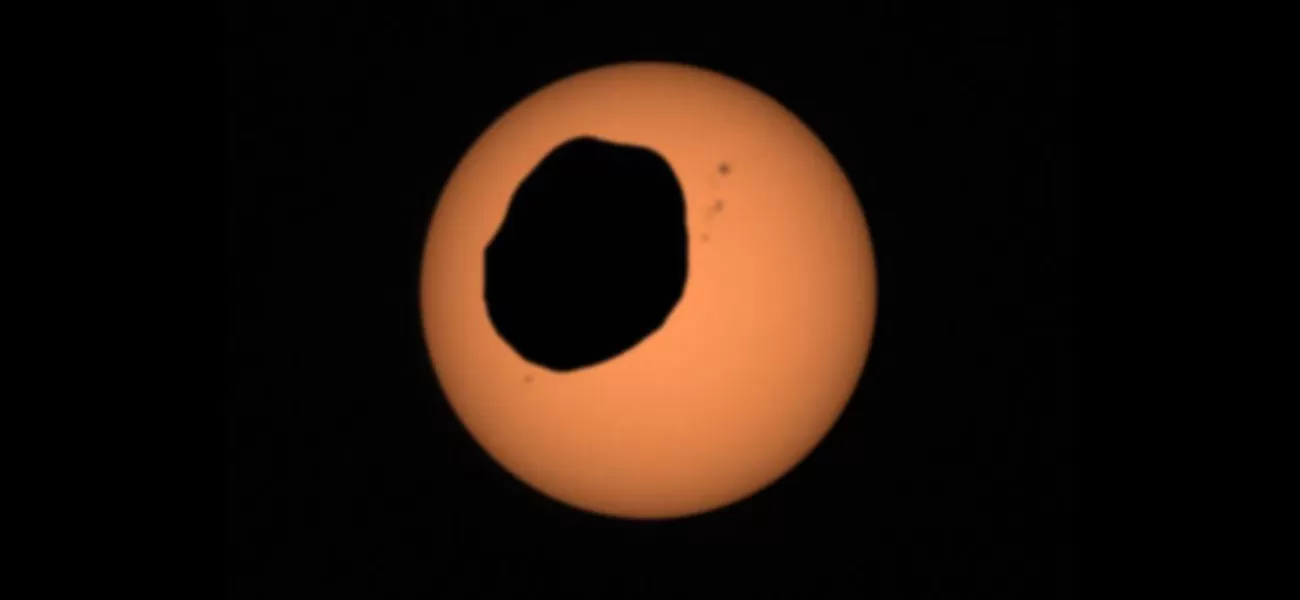Catch a mind-blowing and bumpy solar eclipse on Mars.
Robots enjoy themselves.
February 13th 2024.

Recently, Nasa's Perseverance rover, stationed in the Jezero Crater on Mars, captured an incredible sight - the moon Phobos passing in front of the Sun. This phenomenon, known as a solar eclipse, is a rare event that can usually only be witnessed by robots. However, thanks to the powerful cameras on the rover, us Earthlings are now able to witness this amazing occurrence from millions of miles away.
Phobos, named after the Greek god of fear, is the larger of Mars' two moons and is shaped like a potato. As it made its orbit around the Red Planet on February 8, it partially blocked out the Sun, casting a unique shadow on the Martian surface. The left Mastcam-Z camera on the rover captured this incredible moment, taking 68 images in just over 40 seconds.
But what exactly did Perseverance capture? Well, it was a partial solar eclipse, which occurs when the Moon, or in this case, a moon, doesn't fully block out the Sun. Instead, it creates a misshapen shadow as it moves between Mars and the Sun. The images taken by the rover's camera provide the most detailed and zoomed-in video of a Phobos solar eclipse to date.
Mark Lemmon, an astronomer with the Space Science Institute, described the images as fascinating. He noted that they show intricate details in the shape of Phobos' shadow, such as ridges and bumps on the moon's surface. The camera also captured sunspots, making the eclipse even more unique. Lemmon also pointed out that the images show the eclipse exactly as the rover saw it, giving us a firsthand look at this astronomical event.
For those who may not be familiar with Phobos, here's some background information. It is one of two moons orbiting Mars, the other being Deimos. Phobos completes three orbits around Mars every day and is slowly getting closer to the planet. In fact, it is estimated that in about 50 million years, it will either crash into Mars or break apart and form a ring around the planet.
The moon's surface is rough due to thousands of meteorite impacts, with its most striking feature being the Stickney Crater, which is almost 10 kilometers wide. Phobos was first discovered in 1877 by an American astronomer and orbits Mars at a distance of a few thousand kilometers above the surface. Its gravitational pull on the Red Planet creates small tidal forces, which cause slight changes in the planet's interior and also affect Phobos' orbit.
The eclipse lasted just over 40 seconds, giving the rover ample time to capture stunning images and videos. As Phobos inches closer to Mars, scientists predict that it will eventually crash into the planet or break apart. Only time will tell which fate awaits the Martian moon.
Meanwhile, back on Earth, the next total solar eclipse is set to take place on April 8, 2024. This event will be visible in America and will last for three to four minutes, allowing lucky viewers to witness the Moon completely blocking out the Sun.
In other news, recent studies have shown that bad bacteria could potentially harm the first humans on Mars. Additionally, a mysterious blue orb was spotted on the Martian surface by the Nasa rover. And sadly, Nasa's $85 million Mars rover has officially ended its mission after breaking down. With all these exciting developments happening on the Red Planet, it's clear that Mars will continue to captivate and fascinate us for years to come.
Phobos, named after the Greek god of fear, is the larger of Mars' two moons and is shaped like a potato. As it made its orbit around the Red Planet on February 8, it partially blocked out the Sun, casting a unique shadow on the Martian surface. The left Mastcam-Z camera on the rover captured this incredible moment, taking 68 images in just over 40 seconds.
But what exactly did Perseverance capture? Well, it was a partial solar eclipse, which occurs when the Moon, or in this case, a moon, doesn't fully block out the Sun. Instead, it creates a misshapen shadow as it moves between Mars and the Sun. The images taken by the rover's camera provide the most detailed and zoomed-in video of a Phobos solar eclipse to date.
Mark Lemmon, an astronomer with the Space Science Institute, described the images as fascinating. He noted that they show intricate details in the shape of Phobos' shadow, such as ridges and bumps on the moon's surface. The camera also captured sunspots, making the eclipse even more unique. Lemmon also pointed out that the images show the eclipse exactly as the rover saw it, giving us a firsthand look at this astronomical event.
For those who may not be familiar with Phobos, here's some background information. It is one of two moons orbiting Mars, the other being Deimos. Phobos completes three orbits around Mars every day and is slowly getting closer to the planet. In fact, it is estimated that in about 50 million years, it will either crash into Mars or break apart and form a ring around the planet.
The moon's surface is rough due to thousands of meteorite impacts, with its most striking feature being the Stickney Crater, which is almost 10 kilometers wide. Phobos was first discovered in 1877 by an American astronomer and orbits Mars at a distance of a few thousand kilometers above the surface. Its gravitational pull on the Red Planet creates small tidal forces, which cause slight changes in the planet's interior and also affect Phobos' orbit.
The eclipse lasted just over 40 seconds, giving the rover ample time to capture stunning images and videos. As Phobos inches closer to Mars, scientists predict that it will eventually crash into the planet or break apart. Only time will tell which fate awaits the Martian moon.
Meanwhile, back on Earth, the next total solar eclipse is set to take place on April 8, 2024. This event will be visible in America and will last for three to four minutes, allowing lucky viewers to witness the Moon completely blocking out the Sun.
In other news, recent studies have shown that bad bacteria could potentially harm the first humans on Mars. Additionally, a mysterious blue orb was spotted on the Martian surface by the Nasa rover. And sadly, Nasa's $85 million Mars rover has officially ended its mission after breaking down. With all these exciting developments happening on the Red Planet, it's clear that Mars will continue to captivate and fascinate us for years to come.
[This article has been trending online recently and has been generated with AI. Your feed is customized.]
[Generative AI is experimental.]
0
0
Submit Comment





